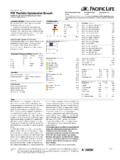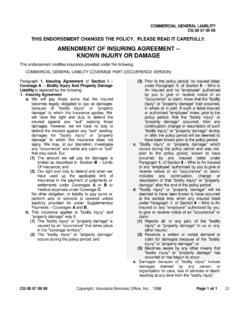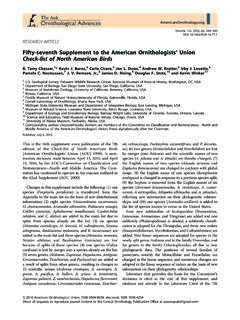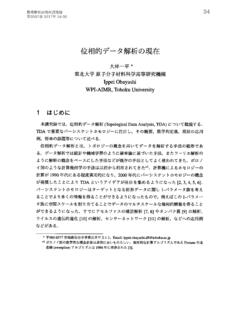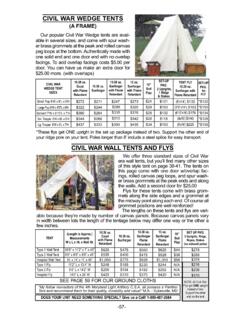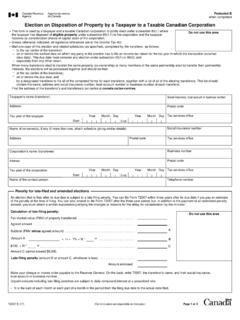Transcription of U.S.Army FM 57-220 8/19/96 Static line parachuting ...
1 Page 1 of 8 8/19/96 FM 57-220 8/19/96 Static line parachuting techniques and training CHAPTER 19 NONSTANDARD AIRCRAFT USED DURING AIRBORNE OPERATIONS This chapter contains aircraft descriptions, JM procedures, and aircraft preparation techniques for nonstandard rotary-wing and fixed-wing aircraft. The aviation supporting unit prepares the aircraft for equipment and personnel drops to include seat and door removal and installation or rearrangement of seat belts. The installation of a field-expedient anchor line cable is the jumpmaster's responsibility. Aircraft preparation is usually accomplished jointly by the loadmaster/crew chief and JM.
2 These aircraft are service tested and approved for personnel airdrop operations. Section I MODIFICATIONS TO JUMP COMMANDS AND JUMPERS' MOVEMENT IN NONSTANDARD AIRCRAFT On some nonstandard aircraft, jumpers are required to shuffle in the aircraft and assume a stand-in-the-door position. The standard jump commands are modified by substituting the command STAND IN THE DOOR for STAND BY. The parachutists execute the shuffle and the stand-in-the-door position in the following manner. 19-1. SHUFFLE The shuffle is a method of moving to the jump door without losing balance or tripping. To perform the shuffle-- a. The jumper's outboard arm is extended down and out to assist maintaining balance and to assume the door position.
3 The other hand grasps the Static line in the correct bight for the aircraft. b. Both feet are slightly spread, directly beneath the body, and staggered 6 to 8 inches. The jumper faces the rear of the aircraft and places his foot nearest the side of the aircraft forward; this foot is the shuffle foot. The foot nearest the center of the aircraft is the trail foot. Page 2 of 8 8/19/96 c. The jumper moves by stepping forward with his shuffle foot 6 to 8 inches and then with his trail foot. He keeps both feet staggered in the same relative heel-and-toe position throughout the shuffle. 19-2. STAND IN THE DOOR At the command STAND IN THE DOOR-- a.
4 The jumpers shuffle toward the jump door, and the number 1 jumper hands his Static line to the safety. b. The number 1 jumper ensures his arm is not entangled with the Static line and shuffles into the door so that the toe of his outboard foot is extended about 2 inches over the edge of the doorsill or jump platform and that his trail foot is about 6 inches to the rear. c. The number 1 jumper keeps his feet shoulder-width apart. His weight is equally distributed on both feet, knees are bent, upper body is straight, his head and eyes are to the front, and hands are outside the aircraft, with fingers extended and joined. He is in a position of "coiled alertness" and is ready to exit the aircraft without further weight adjustment.
5 His hands are not grasping the aircraft but are used to maintain balance. d. The number 2 jumper is in the shuffle position, roughly even with the leading edge of the jump door and facing the rear of the aircraft. e. Follow-on jumpers close up behind the preceding jumper in the shuffle position to maintain balance. 19-3. GO Depending on aircraft requirements, at the command GO the number 1 jumper makes a vigorous up-and-out exit, 6 inches up and 36 inches out. The exit action is gained from the legs alone, and the hands are used only to guide the jumper. On some aircraft, the vigorous exit is essential to avoid hitting the aircraft or coming in contact with another jumper beneath or behind the aircraft.
6 The number 2 jumper and all following jumpers-- a. Shuffle toward the jump door. Page 3 of 8 8/19/96 b. Hand the Static line to the safety and ensure the arm is not entangled with the Static line . c. Shuffle into the door, take up a proper door position, and exit the aircraft without command. A 1-second interval is maintained between jumpers. Section II C-7A CARIBOU The C-7A is a high-wing transport powered by two piston engines (Figure 19-1). A total of 24 parachutists may be dropped using the ramp or doors. The ramp is normally used for dropping parachutists. 19-4. SEATING CONFIGURATION Twenty-four parachutists are seated in two 12-parachutist sticks.
7 Parachutists are loaded over the loading ramp or through the doors. The odd-numbered personnel are seated on the starboard side, and even-numbered personnel are seated on the port side. 19-5. SUPERVISORY PERSONNEL REQUIRED Three personnel supervise safety procedures: one JM who performs standard aircraft check procedures, one safety NCO, and one loadmaster. 19-6. ANCHOR line CABLE ASSEMBLIES Page 4 of 8 8/19/96 There are two anchor line cable assemblies in the C-7A. a. The anchor line cable for ramp jumps runs from the reinforced anchor line attachment plate from the forward bulkhead to the anchor line connector near the right side of the aft starboard door.
8 B. The anchor line cable for door jumps runs from the reinforced anchor line attachment plate down the center of the cargo compartment. It is permanently installed. 19-7. JUMP COMMANDS Jump commands for the C-7A are as follows: a. GET READY. Jumpers respond in the same manner as for other fixed-wing aircraft. b. PORT SIDE PERSONNEL, STAND UP. Jumpers on the left side of the aircraft stand up, raise and secure their seats, and face the ramp of the aircraft. c. STARBOARD SIDE PERSONNEL, STAND UP. Jumpers on the right side of the aircraft stand up, raise and secure their seats, and face the ramp of the aircraft. d. HOOKUP. Even-numbered jumpers hookup between the odd-numbered jumpers to forma continuous stick of jumpers.
9 The jumpers detach the Static line snap hook from the top carrying handle of the reserve parachute and hook up to the anchor line cable with the open portion of the snap hook facing outboard, ensuring that the snap hook locks properly. The safety wire is inserted in the hole, pointing toward the rear of the aircraft, and folded down. The Static line is controlled by each parachutist in a reverse bight at waist level in the left hand. e. CHECK Static LINES, CHECK EQUIPMENT, and SOUND OFF FOR EQUIPMENT CHECK. These commands are executed in the same manner as with other fixed-wing aircraft. f. STAND BY/STAND IN THE DOOR. Page 5 of 8 8/19/96 (1) STAND BY.
10 The number 1 jumper, upon receiving the command STAND BY, assumes a standing position near the starboard side of the ramp hinge. The number 2 jumper stands on the port side of the aircraft slightly to the right of jumper number 1. The remaining personnel close up the interval behind the number 1 jumper. (2) STAND IN THE DOOR. The proper door position is taken by the parachutists in both doors, with the appropriate foot resting on the elevated doorsill. There is no jump platform. g. GO. Personnel exit the aircraft at 1-second intervals. 19-8. RAMP JUMPING The number 1 jumper, upon receiving the command GO, walks off the port side rear corner of the ramp.
